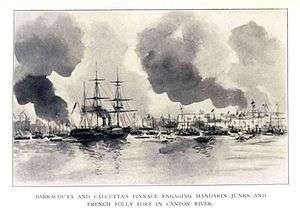HMS Barracouta (1851)
 Barracouta and the boats of HMS Calcutta engaging Mandarin junks in the Canton River on 6 November 1856 | |
| History | |
|---|---|
| Name: | HMS Barracouta |
| Ordered: | 25 April 1847 |
| Builder: | Pembroke Dockyard |
| Cost: | £50,042[Note 1] |
| Laid down: | May 1849 |
| Launched: | 31 March 1851 |
| Commissioned: | 30 July 1853 |
| Fate: | Broken up in 1881 |
| General characteristics [1] | |
| Type: | Paddle sloop |
| Displacement: | 1,676 tons |
| Length: |
|
| Beam: | 35 ft 0 in (10.7 m) oa |
| Depth of hold: | 20 ft 5 in (6.2 m) |
| Installed power: | |
| Propulsion: |
|
| Sail plan: | Barque-rigged |
| Speed: | 10.5 kn (19.4 km/h) |
| Complement: | 100 |
| Armament: |
|
HMS Barracouta was the last paddle sloop built for the Royal Navy. She was built at Pembroke Dockyard and launched in 1851. She served in the Pacific theatre of the Crimean War, in the Second Opium War and in the Anglo-Ashanti wars. She paid off for the last time in 1877 and was broken up in 1881.
Design and construction
Barracouta was designed as a second-class paddle sloop and ordered from Pembroke Dockyard on 25 April 1847. She was armed with two 10-inch (84 cwt)[Note 2] pivot guns and four 32-pounder[Note 3] (25 cwt) guns. Her two-cylinder direct-acting steam engine was provided by Miller, Ravenhill & Salkeld at a cost of £18,228, and produced 300 nominal horsepower, or 881 indicated horsepower (657 kW).[1]
Her armament was changed in 1856, when one of the 10-inch guns was replaced by a 68-pounder (95 cwt) gun, and the 25 cwt 32-pounders were replaced with 42 cwt versions. In 1862 the 68-pounder was replaced by an Armstrong 110-pounder (82 cwt) breech-loading rifle.[1]
Her keel was laid in May 1849[1] and she was launched on 31 March 1851.[2] Her total cost was £50,042 and was the only ship ever built to the design, as well as being the last paddle sloop built for the Royal Navy. She was provided with a barque rig.[1]
Service
Barracouta was commissioned on 30 July 1853[1] in England before being ordered to join the East Indies and China Station in 1854.
China station
From September to mid-October 1854, Barracouta was part of a squadron of four ships led by vice admiral Sir James Stirling. With the start of the Crimean War, Stirling was anxious to prevent Russian ships from sheltering in Japanese ports and menacing allied shipping and led the squadron to Nagasaki where he concluded the Anglo-Japanese Friendship Treaty with representatives of the Tokugawa shogunate. Later during the Crimean War she participated in the siege of Petropavlovsk.[2]
She also participated during the Second Opium War in 1856 before returning to England and being paid off in 1857.[2]
North America station
Barracouta was sent to North America and West Indies Station in 1860 until 1864, before being paid off and then returning to the North America and West Indies Station in 1866. She returned to England in 1870 and was paid off and was used as a tender at the Portsmouth Dockyard.
West Africa station
She served as part of the West Africa Station in 1873 and participated in the Anglo-Ashanti wars.[2]
Australia station
After being refitted in England, Barracouta commenced service on the Australia Station in August 1874.[2] She took part in the Samoan operations in 1876. She left the Australia Station in July 1876 and returned to England and was paid off at the Chatham Dockyard in 1877.[2]
Fate
She was broken up at Chatham in December 1881.[1]
Notes
- ↑ A total cost accounting for inflation of approximately £4,893,500 in today's money.
- ↑ "cwt", or "hundredweight" refers to the weight of the gun itself.
- ↑ "32-pounder" refers to the weight of the shot fired.
Citations
References
- Bastock, John (1988), Ships on the Australia Station, Child & Associates Publishing Pty Ltd; Frenchs Forest, Australia. ISBN 0-86777-348-0
- Winfield, Rif & Lyon, David (2004). The Sail and Steam Navy List: All the Ships of the Royal Navy 1815–1889. London: Chatham Publishing. ISBN 978-1-86176-032-6. OCLC 52620555.
| ||||||||||